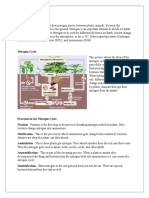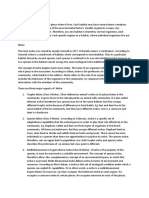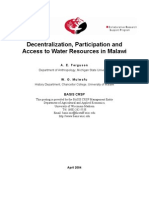Biodiversity
Biodiversity
Uploaded by
ChIrag JainOriginal Description:
Copyright
Available Formats
Share this document
Did you find this document useful?
Is this content inappropriate?
Report this DocumentCopyright:
Available Formats
Biodiversity
Biodiversity
Uploaded by
ChIrag JainCopyright:
Available Formats
Biodiversity
Biodiversity found on Earth today consists of many millions of distinct biological species, the product of four billion years of evolution. However, the word Biodiversity is relatively new, and is thought to have first been coined as a contraction of the term biological diversity in 1985 and then popularized by a number of authors. Bio means life and diversity means difference. So, biodiversity is the different forms of life. Biodiversity is the variety and differences among living organisms from all sources, including terrestrial (land), marine (sea), and other aquatic (water) ecosystems and the ecological complexes of which they are a part. This includes genetic diversity within and between species and of ecosystems. Thus, in essence, biodiversity represents all life. Meaning of Important Terms mentioned in the definition. a) Genetic diversity All forms of life on earth, whether microbes, plants, animals, or human beings, contain genes. Genetic diversity is the sum of genetic information contained in the genes of individual plants, animals, and micro-organisms. Each species is the storehouse of an immense amount of genetic information in the form of traits, characteristics, etc. The number of genes ranges from about 1000 in bacteria to more than 400 000 in many flowering plants. Each species consists of many organisms and virtually no two members of the same species are genetically identical. Some interesting information about genetic diversity in food. Genetic diversity is usually mentioned with reference to agriculture and maintaining food security. This is because genetic erosion of several crops has already occurred leading to the world's dependence for food on just a few species. Currently, a mere 100-odd species account for 90% of the supply of food crops, and three crops rice, maize, and wheat account for 69% of the calories and 56% of the proteins that people derive from plants. b) Species:
Species is a group or class of animals and plants having certain common and permanent characteristics that clearly distinguish it from other groups or species. Members of one species do not breed with those of other species. Biodiversity is most commonly used and measured by species diversity. There are two major reasons for this: species are still the most easily identifiable collective unit of biological organization and the loss of species seems the most irreversible and final of all forms of diversity. How to study species diversity? Species diversity can be expressed in terms of richness that is the number of species in an area for example you can count the number of plant species in your garden which will give you the species richness of your garden. Thus for example if you have one neem tree and one mango tree in your garden the tree species richness of your garden will be two. Ecologists have come up with various diversity indices, which focus not only on the number of species present but also on the number of individuals of a particular species. Thus for example if you have two neem trees in your garden, this value will be reflected in the diversity index. Diversity indices are of more value to ecologists, since they give an idea of the composition of the communities existing in an area, and help identify species that dominate the community in terms of their abundance, biomass or cover. c) Ecosystem It is a place where nature has created a unique mixture of air, water, soil, and a variety of living organisms to interact and support each other. It is the living community of plants and animals of any area together with the non-living components of the environment such as soil, air, and water. The living and the non-living interact with each other in such a manner that it results in the flow of energy between them. In a particular ecosystem the biotic community consists of the birds, reptiles, mammals, insects and other invertebrates, bacteria, plants, and other living organisms. An ecosystem includes not only the species inhabiting an area, but also all the features of the physical environment. An ecosystem can exist in any place where there are varied forms of life. Even the park near your home or a village pond can be an ecosystem as there are different forms of life here and they coexist.
These three things mentioned above are also known as levels of biodiversity.
Biodiversity in India
India is one of the mega biodiversity centers in the world and has two of the world's 18 biodiversity hotspots located in the Western Ghats and in the Eastern Himalayas. The forest cover in these areas is very dense and diverse and of pristine beauty, and incredible biodiversity. According to a MoEF Report (1996), the country is estimated to have over 45,000 plant species and 81,000 animal species representing 7% of the worlds flora (plants) and 6.5% of its fauna (animals). The 1999 figures are 49,219 plant species representing 12.5% and 81,251 animal species representing 6.6%. The sacred groves of India are some of the areas in the country where the richness of biodiversity has been well preserved. The Thar desert and the Himalayas are two regions rich in biodiversity in India. There are 89 national parks and 504 wildlife sanctuaries in the country, the Chilika Lake being one of them. This lake is also an important wetland area. Learn more through map on biodiversity in India. Over the last century, a great deal of damage has been done to the biodiversity existing on the earth. Increasing human population, increasing consumption levels, and decreasing efficiency of use of our resources are some of the causes that have led to overexploitation and manipulation of ecosystems. Trade in wildlife, such as rhino horn, has led to the extinction of species. Consequences of biodiversity loss can be great as any disturbance to one species gives rise to imbalance in others. To prevent such loss, the Government of India is setting up biosphere reserves in different parts of the country. These are multipurpose protected areas to preserve the genetic diversity in different ecosystems. Till 1999, ten biosphere reserves had been set up, namely Nilgiri, Nandadevi, Nakrek, Great Nicobar, Gulf of Mannar, Manas, Sunderbans, Similipal, and Dibru Saikhowa. A number of NGOs are being involved in the programme to create awareness. But legal protection is provided only to national parks and sanctuaries, which cover about 4.5% of Indias land area.
Eastern Himalayas The Eastern Himalayas comprise the tracts of the Darjeeling Hills or North Bengal, Sikkim, Arunachal Pradesh, and eastern Bhutan. The region is drained by the Brahmaputra river and its tributaries: the Teesta drains Sikkim and the Darjeeling areas, and the Manas drains part of Bhutan and Arunachal Pradesh. The Kamang and the Subansiri are the other important rivers that drain the eastern Himalayas. The forests are moist, dense, evergreen, semi-evergreen, or temperate. Precipitation is very high and the forest region is very humid. Sal forests and evergreen trees are found extensively all along the foothills of the Eastern Himalayas. This region is the home of a large variety of animals and birds including slow loris, rhinoceros, the golden languar, tiger, the Indian civet, clouded leopard, the golden cat. The birds include heron, the white-winged wood duck, and the snow cock. A number of wildlife sanctuaries and biosphere reserves have been set up in this region to protect the species from poachers and human encroachments. Western Ghats The Western Ghats comprise the mountain range that runs along the western coast of India, from the Vindhya-Satpura ranges in the north to the southern tip. It covers Amboli, Radhanagari, Mahabaleshwar, Bhimashanker, Mulsi and Mundunthurai. There is a great variety of vegetation all along the Ghats: scrub jungles, grassland along the lower altitudes, dry and moist deciduous forests, and semi-evergreen and evergreen forests. There are two main centres of diversity, the Agashyamalai hills and the Silent Valley. The complex topography and the heavy rainfall have made certain areas inaccessible and have helped the region retain its diversity. Almost one-third of all the flowering plant species in India are found in this region. Of the 450-odd plants found in this region, 40% are endemic (these are species that have adapted to this particular area and the conditions existing in it.) There is an equal diversity of animal and bird life.
Biodiversity Loss Decrease in number of various forms of life is known as biodiversity loss. Species are becoming extinct at the fastest rate known in geological history, and most of these extinctions are tied to human activity. Some conservation organizations estimate species are heading towards extinction at a rate of about one every 20 minutes. One figure frequently cited is that the rapid loss of species we are seeing today is estimated to be between 1,000 and 10,000 times higher than the natural extinction rate. Experts calculate that between 0.01 and 0.1 per cent of all species will continue to become extinct each year, if we carry on with business as usual. Main Causes of Biodiversity Loss Habitat loss and destruction This is one of the greatest threats to biodiversity. Habitat loss is directly linked to human induced pressures on land. Human beings, in fact, have deeply modified the territory, as a result of a large growth in the population, industrial development, the expansion of transportation networks, and agriculture and fishing on an industrial scale. Alterations in ecosystem composition Grouping of species and their interactions with their ecosystems are critical for not only saving the species, but also for their successful future evolution. In the event of alterations, either within species groups, or within the environment, entire ecosystems can begin to change. Alterations to ecosystems are a critical factor contributing to species and habitat loss. Invasive alien species The introduction of exotic species that replace local and native species is cited as the second largest cause of biodiversity loss. Alien invasive species replace, and often result in the extinction of native species. The annual economic damage caused by invasive plant and animal species is estimated to be in the region of US$ 1.4 trillion. Over-exploitation Over-hunting, over-fishing or over-collecting of a species can quickly lead to its decline. Changing consumption patterns of humans is often cited as the key reason for this unsustainable exploitation of natural resources.
Pollution and Contamination Biological systems respond slowly to changes in their surrounding environment. Pollution and contamination cause irreversible damage to species. Global climate change Both climate variability and climate change cause biodiversity loss. Species and populations may be lost permanently, if they are not provided with enough time to adapt to changing climatic conditions.
Biodiversity Conservation To protect the number and variety of plants and animals is known as biodiversity conservation. Why Biodiversity Conservation is required? Biodiversity conservation provides substantial benefits to meet immediate human needs, such as clean, consistent water flows, protection from floods and storms and a stable climate. The loss of biodiversity is dangerous and its consequences are immediate: Fewer opportunities for livelihoods, for better health, education, and a better life Fewer fish in the sea, means less food for our survival A lack of clean water means water born diseases and water wars. A lack of forest resources such as food, or plants for medicine In the long term, it also means less income for communities, which are often already amongst the poorest on Earth Methods for biodiversity conservations There are two Methods of biodiversity conservation
In-situ biodiversity conservation (Natural Home)
In this case, an area is identified with high biodiversity. Then this area is isolated and protected from human activities by establishing a natural park/sanctuary/biosphere reserve etc. It is very essential for big animals like elephants, rhinos, tigers: they require huge area.
National Park Wildlife Sanctuary
Biosphere reserve
No human activity or settlement allowed. Villagers cannot graze their animals, Extremely strict rules about jungle produce collection (Tendu leaves, Honey etc.) People are not allowed to live (some exceptions though) but some human activities are allowed, such as grazing, firewood collection. Tourism is permitted. A Sanctuary can be upgraded as a National Park. However a National Park cannot be downgraded as a Sanctuary. People are allowed to live, own private land and carry on their traditional activities. (In the outer-zone)
Seed Banks They store seeds at extremely low temperature and humidity. Advantage: can save large variety of plant species in a very small space.
Zoos You can bring some endangered species in zoo, try to breed them, and reintroduce their offsprings in the jungle. (Done in case of pandas, orangutans etc.) CENTRAL ZOO AUTHORITY of India Enforces minimum standards and norms for upkeep and health care of animals in Indian Zoos Restrains mushrooming of unplanned and ill-conceived Zoos that were cropping up as adjuncts to public parks, industrial complexes and waysides.
Zoo Problems Not all species can breed in captivity. Life expectancy of Caged Ex-situ animal is less compared to its in-situ cousin. Offsprings born in captivity, have problems in adjusting and surviving in jungles. Tiger cub born in zoo, feeding on readymade meat, living in a small area, cannot easily survive in a jungle. It doesnt know how to efficiently move in a jungle and hunt animals. Zoos require huge land, lot of funds, trained personnel. Zoos concentrate on protection and breeding of big and popular species such as Tiger, Panda, orangutans, etc. as it brings more public support and funds. But small and unknown species such as frogs and birds get neglected. Zoos You can bring some endangered species in zoo, try to breed them, and reintroduce their offsprings in the jungle. (done in case of pandas, orangutans etc.)
CENTRAL ZOO AUTHORITY of India Enforces minimum standards and norms for upkeep and health care of animals in Indian Zoos Restrains mushrooming of unplanned and ill-conceived Zoos that were cropping up as adjuncts to public parks, industrial complexes and waysides.
Zoo Problems Not all species can breed in captivity. Life expectancy of Caged Ex-situ animal is less compared to its in-situ cousin. Offsprings born in captivity, have problems in adjusting and surviving in jungles. Tiger cub born in zoo, feeding on readymade meat, living in a small area, cannot easily survive in a jungle. It doesnt know how to efficiently move in a jungle and hunt animals.
Zoos require huge land, lot of funds, trained personnel. Zoos concentrate on protection and breeding of big and popular species such as Tiger, Panda, orangutans, etc. as it brings more public support and funds. But small and unknown species such as frogs and birds get neglected.
Botanical Gardens (Ex-situ)
for example, BOTANIC GARDEN OF THE INDIAN REPUBLIC (BGIR), NOIDA has been set up to facilitate ex situ conservation and propagation of rare and threatened indigenous plants of the country Problem: area and funds: They do not get as much media attention, public support and charity like the zoos.
Solutions for Biodiversity Conservation and Sustainable Development There are a number of initiatives aimed at enhancing sustainable development and promoting beneficial conservation of biodiversity in countries around the world. These include: 1. The Green Economy Initiative has been defined as one which will accelerate the transition to a low-carbon, resource-efficient economy able to meet multiple challenges, and deliver multiple opportunities for the twenty-first century. 2. Promoting an increase in the number, size, and connectivity of protected areas, both on land and at sea. 3. Increasing focus on the implementation of Multilateral Environmental Agreements related to biodiversity such as: The Convention on Biological Diversity (CBD) The Convention on International Trade in Endangered Species of Wild Fauna and Flora (CITES) The Convention on Migratory Species (CMS) The Ramsar Convention on Wetlandsand The World Heritage Convention
4. Increasing Communication, Education and Public Awareness (CEPA) programmes related to biodiversity with an aim to relate biodiversity to people and their livelihoods so that the ownership for saving biodiversity is spread and everyone feels responsible for stopping loss.. 5. Identifying and creating opportunities for rural enterprises based on biodiversity such as ecotourism, bio-prospecting to benefit local communities, the environment, species and their habitats. 6. Encouraging development that is sustainable and based on biodiversity by drawing attention to regions that might otherwise be developed in an unsustainable way. 7. Providing important economic and social benefits that provide local communities and incentives for habitat protection. 8. Identification of options for sharing the benefits of conservation and sustainable use with local communities and stakeholders.
National Biodiversity Authority, India The National Biodiversity Authority (NBA) was established in 2003 to implement Indias Biological Diversity Act (2002). The NBA is Autonomous body and that performs facilitative, regulatory and advisory function for Government of India on issue of Conservation, sustainable use of biological resource and fair equitable sharing of benefits of use. The Biological diversity Act (2002) mandates implementation of the act through decentralized system with the NBA focusing on advice the Central Government on matters relating to the conservation of biodiversity, sustainable use of its components and equitable sharing of benefits arising out of the utilization of biological resources; advice the State Government in the selection of areas of biodiversity importance to be notified under sub-section (1) of section 37 as heritage sites and measures for the management of such heritage sites. The NBA with its Headquarters in Chennai, India delivers its mandate through a structure that comprises of the Authority, secretariat, State Biodiversity Boards (SBBs), Biodiversity Management Committees (BMCs) and Expert Committees. Since its establishment, NBA has supported creation of SBBs in 28 States, facilitated establishment of around 32,131 BMCs, advised notification. The state Biodiversity Board (SBBs) advice the State Government on matters relating to the conservation of biodiversity, sustainable use of its components and equitable sharing of the benefits arising out of the utilization of biological resources. It is also a regulatory body for granting of approvals or otherwise request for commercial utilization or biosurvey and bio-utilization of any biological resource by Indians. Local Level Biodiversity Management committees (BMCs) is responsible for promoting conservation, sustainable use and documentation of biological diversity including preservation of habitats, conservation of land races, folk varieties and cultivators, domesticated stocks and breeds of animals and microorganisms
Greenhouse gases have quadrupled since the 1950s. 20% of the worlds population lacks access to safe drinking water and 50% to sanitation systems. 80% of the worlds original forest cover has been cleared or degraded and 39% of the remaining forest is threatened by mining or logging projects. 25% of the world's mammal species may be totally extinct. More than 50% of the worlds coral reefs are threatened
You might also like
- Environment The Science Behind The Stories Second Canadian Edition With Myenvironmentplace Canadian 2nd Edition Withgott Test BankDocument22 pagesEnvironment The Science Behind The Stories Second Canadian Edition With Myenvironmentplace Canadian 2nd Edition Withgott Test Bankherbistazarole5fuyh6100% (30)
- Energy Flow Through The EcosystemDocument5 pagesEnergy Flow Through The EcosystemCiprian BitcaNo ratings yet
- Theories of EntrepreneurshipDocument21 pagesTheories of EntrepreneurshipChIrag Jain100% (7)
- Minimum Wage - PhilippinesDocument7 pagesMinimum Wage - PhilippinesInhenyero TsupiteroNo ratings yet
- Unit 4 Environmental BiodiversityDocument67 pagesUnit 4 Environmental BiodiversityRudyNo ratings yet
- Biodiversity and Its ConservationDocument9 pagesBiodiversity and Its ConservationChinnam rama krishna100% (1)
- Effects of EarthquakeDocument4 pagesEffects of EarthquakeRichard PascoNo ratings yet
- Atmosphere of EarthDocument10 pagesAtmosphere of EarthDen Mark AlbayNo ratings yet
- Law of The Limiting FactorsDocument4 pagesLaw of The Limiting FactorsBiswajit DarbarNo ratings yet
- Biodiversity at Global LevelDocument23 pagesBiodiversity at Global LevelShantanu Sharma67% (3)
- Biodiversity PPT2Document32 pagesBiodiversity PPT2JOSHUA SEGUERRANo ratings yet
- Structure of Ecosystem Biotic and Abiotic ComponentsDocument3 pagesStructure of Ecosystem Biotic and Abiotic ComponentsRachana GopalNo ratings yet
- Jonerosto M. Sinangote Ece 122Document3 pagesJonerosto M. Sinangote Ece 122NeroSinangote100% (1)
- Lab 14 Ecology - Carrying Capacity - OutdoorDocument11 pagesLab 14 Ecology - Carrying Capacity - Outdoor13ucciNo ratings yet
- Ecosystem Structure and Types EcosystemDocument27 pagesEcosystem Structure and Types EcosystemMOVIES star100% (1)
- Unit Bryophyta (Paper Code 502)Document47 pagesUnit Bryophyta (Paper Code 502)Abhishek Singh Chandel0% (1)
- Ecological Succession by Isaiah Erin MoniqueDocument20 pagesEcological Succession by Isaiah Erin Moniqueisaiah roland100% (1)
- Biodiversity and ConservationDocument76 pagesBiodiversity and ConservationVishnu Mohan100% (2)
- Environmental ScienceDocument25 pagesEnvironmental ScienceFobe Lpt NudaloNo ratings yet
- Bio MagnificationDocument6 pagesBio Magnificationmukesh bhatiNo ratings yet
- Bio DiversityDocument2 pagesBio DiversityHesperus M Junior100% (1)
- Ecological NicheDocument3 pagesEcological NicheBiju ThomasNo ratings yet
- Habituation Earthworm-Responsiveness-SsDocument3 pagesHabituation Earthworm-Responsiveness-SsMasthankhan PatanNo ratings yet
- 2 EcosystemsDocument68 pages2 EcosystemsSanjana SNo ratings yet
- IucnDocument34 pagesIucnsaaisNo ratings yet
- 5 Gene InteractionDocument9 pages5 Gene InteractionPrem ShuklaNo ratings yet
- Biogeochemical CyclesDocument25 pagesBiogeochemical CyclesAlokfriNo ratings yet
- Ecology A Branch of Biology (From Greek: "House" and "Study Of") Is TheDocument4 pagesEcology A Branch of Biology (From Greek: "House" and "Study Of") Is TheImmanuel HostNo ratings yet
- Forest Conservation - Useful Methods For Forest ConservationDocument9 pagesForest Conservation - Useful Methods For Forest ConservationkimmiahujaNo ratings yet
- Community EcologyDocument60 pagesCommunity EcologyBom ChanNo ratings yet
- Zoo Lab Frog ActivityDocument12 pagesZoo Lab Frog ActivityAdznaira AmilussinNo ratings yet
- The Atmosphere: Composition and StructureDocument31 pagesThe Atmosphere: Composition and StructureDoods GaldoNo ratings yet
- History of IchthyologyDocument7 pagesHistory of Ichthyologyikhlash8No ratings yet
- 21 Bioprospecting Pros and ConsDocument5 pages21 Bioprospecting Pros and ConsShruti PillaiNo ratings yet
- Limiting Factors and ToleranceDocument18 pagesLimiting Factors and Tolerancearvinric83% (6)
- Effects of Massive Growth of Invasive Alien Species in The Philippine BiodiversityDocument35 pagesEffects of Massive Growth of Invasive Alien Species in The Philippine BiodiversityRoselyn B. Manansala100% (1)
- MINAMATADocument1 pageMINAMATARichardDinongPascualNo ratings yet
- ScienceDocument3 pagesScienceEdelyn UnayNo ratings yet
- Molisch TestDocument5 pagesMolisch TestPatricia de LeonNo ratings yet
- 6.LECTURE 6 - TaxonomyDocument35 pages6.LECTURE 6 - TaxonomyMuhammad Danial HasanNo ratings yet
- Basic Concepts To BotanyDocument6 pagesBasic Concepts To BotanyPrincess De LeonNo ratings yet
- Enzymes and VitaminsDocument41 pagesEnzymes and VitaminsMonika Kshetri100% (1)
- Environment and Ecology Notes Unit 2Document25 pagesEnvironment and Ecology Notes Unit 2divyanshu potaliyaNo ratings yet
- BiodiversityDocument22 pagesBiodiversityBen Ritche Layos50% (4)
- BiodiversityDocument63 pagesBiodiversitySreejithk2015No ratings yet
- Framework For Philippine Plant Conservation Strategy and Action Plan 1Document45 pagesFramework For Philippine Plant Conservation Strategy and Action Plan 1Jmp JmpNo ratings yet
- Difference Between Cold-Blooded and Warm-Blooded AnimalsDocument5 pagesDifference Between Cold-Blooded and Warm-Blooded AnimalsShakil AhmedNo ratings yet
- Molecular Composition of CellsDocument92 pagesMolecular Composition of CellsJb PalmaNo ratings yet
- Chapter 4-BiodiversityDocument71 pagesChapter 4-BiodiversityRintu Raj PandeyNo ratings yet
- Ecosystem and Its ComponentsDocument20 pagesEcosystem and Its ComponentsarunbvijayNo ratings yet
- Air PollutionDocument10 pagesAir PollutionSandhya KakkarNo ratings yet
- Ecosystem DiversityDocument1 pageEcosystem Diversityliezl ann g. valdezNo ratings yet
- People and Earth's Ecosystems For Nursing Syllabus 2nd Sem 2020-2021Document8 pagesPeople and Earth's Ecosystems For Nursing Syllabus 2nd Sem 2020-2021Lea Angel Dominique MacamNo ratings yet
- Protochordates PPT Short Cut Summer 2014Document20 pagesProtochordates PPT Short Cut Summer 2014PattyNo ratings yet
- Environmental Science MidtermDocument12 pagesEnvironmental Science MidtermJillian Cyrene LimenNo ratings yet
- BiodiversityDocument32 pagesBiodiversityPrateek Gandhi100% (1)
- River Water Quality and PollutionDocument20 pagesRiver Water Quality and PollutionDaryl BartolomeNo ratings yet
- Module 3 Activity Central DogmaDocument5 pagesModule 3 Activity Central DogmaNORODIN DALANDAS0% (1)
- Basics of EcologyDocument15 pagesBasics of Ecologychoudhary2k8100% (1)
- Biochemistry Chapter 1Document115 pagesBiochemistry Chapter 1habteNo ratings yet
- Aquatic BiomesDocument31 pagesAquatic Biomesapi-234480965No ratings yet
- Energy Flow in EcosystemsDocument36 pagesEnergy Flow in EcosystemsCllyan ReyesNo ratings yet
- Biologial DiversityDocument22 pagesBiologial Diversityvikas21014005No ratings yet
- A Brief Pepsi HistoryDocument15 pagesA Brief Pepsi HistoryChIrag JainNo ratings yet
- Entrepreneurial Class and Socio-Economic EnvironmentDocument33 pagesEntrepreneurial Class and Socio-Economic EnvironmentChIrag JainNo ratings yet
- Fantastic 206 Sports Club: Computer Application ProjectDocument1 pageFantastic 206 Sports Club: Computer Application ProjectChIrag JainNo ratings yet
- Urban SprawlDocument1 pageUrban SprawlNeha ranadeNo ratings yet
- Forests: Deforestation and DesertificationDocument15 pagesForests: Deforestation and DesertificationFaiza NoorNo ratings yet
- Conservation of WetlandsDocument3 pagesConservation of WetlandsAtul TirkeyNo ratings yet
- VM0015 Methodology For Avoided Uplanned DeforestationDocument185 pagesVM0015 Methodology For Avoided Uplanned DeforestationDavid GiraldoNo ratings yet
- Kikuyu Grass Lawn Establishement - BoraDocument3 pagesKikuyu Grass Lawn Establishement - BoraDaniel GmichaelNo ratings yet
- Geo CH 3Document5 pagesGeo CH 3lydia potterNo ratings yet
- Malawi Water Resources Decentralization and ParticipationDocument36 pagesMalawi Water Resources Decentralization and ParticipationMwabutwa100% (1)
- Gorter 2011 Towards Deliberative Governance, Rethinking ParticipationDocument273 pagesGorter 2011 Towards Deliberative Governance, Rethinking ParticipationRendt GorterNo ratings yet
- Waterfront Master Plan - Final June 2010Document118 pagesWaterfront Master Plan - Final June 2010Hugo Rodrigues100% (1)
- ARM 205 DigitizedDocument55 pagesARM 205 DigitizedPegNo ratings yet
- Irrigation Tank CalculationsDocument1 pageIrrigation Tank Calculationssohaib ahmedNo ratings yet
- Agrostology (From: Agrōstis, "Type of Grass" andDocument5 pagesAgrostology (From: Agrōstis, "Type of Grass" andKavieswarNo ratings yet
- 03 PhilippinesDocument13 pages03 PhilippinesHenry TiredNo ratings yet
- Subsoil Drainage DesignDocument68 pagesSubsoil Drainage DesignparthivNo ratings yet
- The Origins of Agriculture: Years Ago, We Began To Domesticate Plants and Animals As A Way To Make OurDocument3 pagesThe Origins of Agriculture: Years Ago, We Began To Domesticate Plants and Animals As A Way To Make OurRoger AndrewNo ratings yet
- HOR.111 - Fundamentals of Horticulture (1+1) Utility of The CourseDocument4 pagesHOR.111 - Fundamentals of Horticulture (1+1) Utility of The CourseKavieswarNo ratings yet
- Garden Services BizHouse - UkDocument3 pagesGarden Services BizHouse - UkAlex BekeNo ratings yet
- UK A Whole Life Costing Approach For Rainwater Harvesting Systems: Introduction - Bradford UniversityDocument7 pagesUK A Whole Life Costing Approach For Rainwater Harvesting Systems: Introduction - Bradford UniversityFree Rain Garden ManualsNo ratings yet
- Costing Landscaping Works2Document5 pagesCosting Landscaping Works2faiz salimNo ratings yet
- Impact of Bohol Irrigation System Project Phase 2 (BIS II) On Rice FarmingDocument1 pageImpact of Bohol Irrigation System Project Phase 2 (BIS II) On Rice FarmingIRRI_SSDNo ratings yet
- 13 Outstanding Water Conservation MethodsDocument5 pages13 Outstanding Water Conservation MethodsjunaidNo ratings yet
- Irrigation Engineering CE-408 (2+1)Document63 pagesIrrigation Engineering CE-408 (2+1)Umer Waheed50% (2)
- Hotel DesignsDocument60 pagesHotel DesignsArchijenny Daileg93% (14)
- Hubballi-Ankola Rail ProjectDocument1 pageHubballi-Ankola Rail ProjectsoujanyaNo ratings yet
- Piping Inspection ChecklistDocument5 pagesPiping Inspection Checklistsbmmla100% (2)
- Forest Resources Management - Sustainable Resources Management - SUNY ESFDocument3 pagesForest Resources Management - Sustainable Resources Management - SUNY ESFleo leoNo ratings yet
- Water Resource Management in HillsDocument11 pagesWater Resource Management in HillsYashdeep SinghNo ratings yet
- Agricultural Land and Capital GainsDocument8 pagesAgricultural Land and Capital Gainsrandhir.sinha1592No ratings yet





























































































